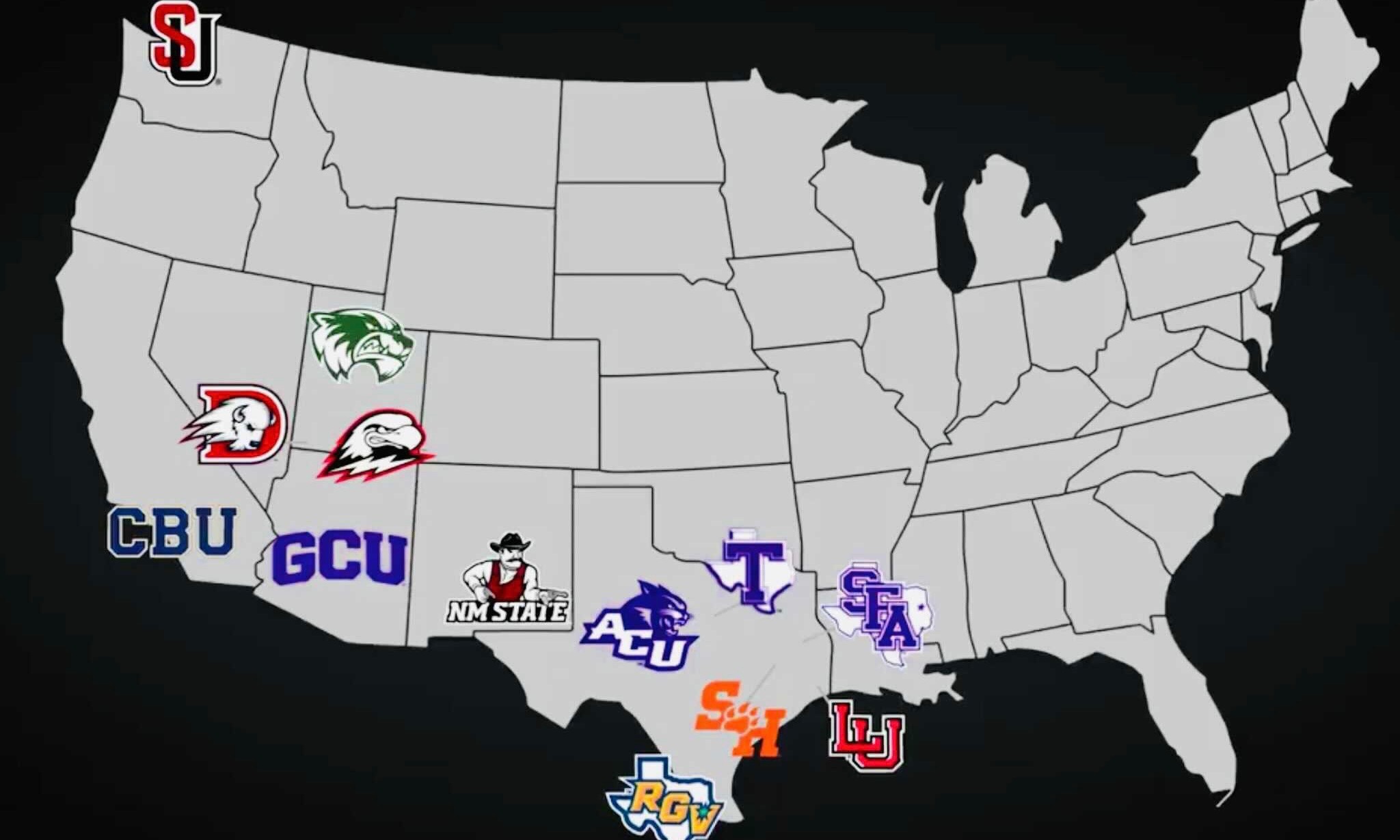Houston- Football is officially back in the WAC. As soon as next season, college football fans will be able to enjoy #Waction football for the first time in a decade. The WAC was one was the top-tier conference for mid-major football for over four decades. The conference had multiple cinderella runs and hosted some all-time great mid-major teams from Chris Peterson’s Boise State run from 2007-2012, Pat Hill’s early 2000s Fresno State team, Colin Kapernick’s 2009-2010 conference championship run at Nevada, and we could never forget Colt Brennan’s 13-1 Hawaii team. The conference was the biggest loser in conference realignment in 2012 and had to give up football entirely when schools fled to different conferences. After a decade hiatus, the conference announced its back in the football business.
The Western Athletic Conference held a press conference early Thursday detailing the conference additions; Southern Utah, Abeline Christian, Lamar, Stephen F Austin, and Sam Houston State will all join the conference and resurrect football. All five near members will also compete in all of the Olympic sports and add much-needed depth to the strong basketball side of the conference. This will create a large 13 team conference that stretches Geographically from Seattle to East Texas. The conference will split up into two different divisions to help limit travel. The structure of using two divisions will help benefit the structure of the conference and help keep programs economically stable. GCU president added, “the divisions will keep the Olympic sports alive.” This is important for athletic departments whose funding has been crippled by the Covid shutdown and testing requirements.
In football, the school will host a seven-team FCS conference and will be joined by WAC members Dixie State and Tarleton State, who moved up from D2 ranks last year. “With the four new schools, the WAC has more members in the state of Texas than any other (Division I) conference,” Hurd said. Having a strategical influence in Texas and the southwest was made a big emphasis by the WAC.
As for timing, the four Texas schools will join in July 2021, while Southern Utah will join the party a year later in July of 2022. The accelerated timing is the result of the Southern Conference’s willingness to expedite the release of the four Southland schools: Lamar, Stephen F Austin, ACU, and Sam Houston State.
“I cannot overstate my level of excitement in making this expansion announcement,” said Hurd, “The opportunity to bring five quality institutions into the conference, to significantly strengthen the WAC’s national basketball brand and other championship sport profiles, and to bring football back under the WAC umbrella is one that made sense.”
For next year, the conference will need to apply for a waiver to get “AQ” status for the FCS playoff since Tarleton State and Dixie State are both transitioning division schools and are not eligible for the postseason. Commissioner Jeff Hurd revealed the conference is still looking to add another school to the news conference and prefers a program that is geographically suitable for Texas. There are also maybe plans to move the conference to the FBS level in the future, but the WAC is focused on making the FCS work.
While the WAC football resurrection is the main headline, this going to have a major impact in the college basketball world as well. The WAC has been constantly dominated by New Mexico State over the past decade. The additions of Stephen F Austin and emerging Abeline Christian, both schools that have had NCAA tourney appearances in the last four years, will give New Mexico State much-needed competition. Add those teams to two emerging mid-major powers in Grand Canyon and Cal Baptist, the WAC now has five legitimate contenders and it might make the WAC good enough to be a multi-bid conference in any given year.
Less than a decade ago the WAC was on its clear deathbed. This is the best spot the WAC has been since Boise St was a national championship contender, and the basketball conference was so good it hosted hoisting weeknight primetime ESPN basketball slots in the late ’90s. After failing in irrelevancy over the last decade, the conference looks like finally on the way back. The expansion of the conference comes at the perfect time, on the eve of the WAC’s time to discuss a new media rights deal with ESPN. The new reach of the conference covers the entire southwest and elevates the conference’s brand. WAC commissioner Jeff Hurd will have the negotiation ammunition to put together a media package that will give the conference more exposure. When asked about how the expansion impacts media rights discussion Hurd said,
“The addition of the new schools puts us in a better position. ” Hurd said “The expansion is a timely one, we are scheduled to renegotiate a deal with ESPN next year, and hope to do something that makes sense for the conference, or we will move on to different media opportunities if we have to.”
The expansion has greatly enhanced the conference by opening up a new market in Texas and football, provided financial and competitive stability, enhanced the brand, created more competition and rivalries. The resurrection of the WAC has been a great story. The conference was on the edge of survival just six years ago. Now it’s mounting an incredible comeback and has to chance to become one of the better mid-major conferences in collegiate sports.
Based on the way things are trending, don’t be surprised if late WAC games were shown on ESPN 2 again. When it happens, it’s guaranteed- late-night #WACTION is going to be must-see tv.




